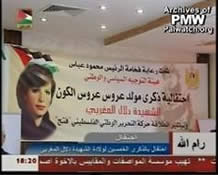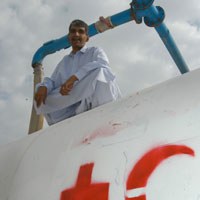Published: march 21, 2010; Intelligence and Terrorism Information Center.
Turning Shaheeds into Role Models: Fatah unofficially inaugurated the Dalal al-Magribi Square in Al-Bireh, named after a Fatah terrorist who participated in the mass-murder attack on Israel’s Coastal Road (1978).
Three months ago the Palestinian Authority announced that on March 11, 2010, an official ceremony would be held in the town of Al-Bireh (in the vicinity Ramallah) to inaugurate the Dalal al-Magribi Square. The square was erected to honor al-Magribi, a female Palestinian terrorist who participated in the March 1978 mass-murder attack on Israel’s Coastal Road. Since the mass-murder attack, in which 37 Israelis were murdered and 71 wounded, Dalal al-Magribi has become a kind of national heroine, whose action was lauded by Yasser Arafat and who has been commemorated and praised by the Palestinian Authority.

Inaugurating Dalal al-Magribi Square in Al-Bireh, March 11, 2010. Holding the center of the banner is senior Fatah figure Tawfiq Tirawi (Al-Quds TV, March 12, 2010)
Shortly before the ceremony was scheduled to take place the Palestinian Authority announced it would be cancelled for “technical reasons.” According to the Al-Bireh municipality, the reason was Israeli pressure on the Palestinian Authority (Reuters, March 10, 2010). Palestinian spokesmen, on the other hand, were quick to proclaim that no power in the world could prevent them from feeling pride in their history.
Despite the cancellation, which in our assessment was the result of the Palestinians’ desire to placate the Americans in light of Vice President Biden’s visit, the ceremony was held on the appointed day, but unofficially. On March 11 dozens of Palestinian youths came to the square to participate. Senior Fatah figures were in attendance, notably Tawfiq Tirawi, a member of Fatah’s Central Committee, Mustafa Abu Rabbi’a, a senior Fatah figure in Ramallah, and Jamal Hawil, a member of the Fatah faction in the Palestinian Legislative Council. A large picture of the terrorist was set up in the square.

Birthday celebration for Dalal al-Magribi held by Fatah’s National Political Guidance Committee (Wafa News Agency, January 16, 2010)
The official Palestinian media covered the event and devoted a number of programs and newspaper columns to it, emphasizing the Dalal al-Magribi’s importance and action:
A. On March 11, the official Palestinian TV station broadcast a memorial program to honor her legacy. Her sister Rashida (who is currently an officer in the Palestinian Authority security forces) appeared on the program. She said “Today is a day of pride and victory for the Palestinian people and a day of pain for the Zionists,” and asked the viewing audience to gather in the square (MEMRI, March 17, 2010).
B. Writing for Al-Hayat Al-Jadeeda, ‘Adel Abd al-Rahman wondered why Israel was allowed to commemorate its people while not permitting the Palestinian Authority to do the same (Al-Hayat Al-Jadeeda, March 14, 2010).
C. Al-Ayam published a number of articles and columns about al-Magribi. An article written by Muhammad Abd al-Hamid represented her as a “freedom fighter.” A column written by Raja Rantisi claimed that if she were to return today she would no doubt be pleased by what she saw (Al-Ayam, March 14, 2010).
At the same time, the de facto Hamas administration announced it would name two main squares in Gaza City for female shaheeds. One would be dedicated to Dalal Magribi and the other to Rim al-Riyashi, a Hamas suicide bomber, who on January 14, 2004, blew herself up at the workers’ terminal at the Erez crossing. (The blast killed three Israeli soldiers and one civilian, and wounded ten others.) According to the announcement, the decision to rename the squares was the result of the Hamas administration’s faith “in the honorable history of the resistance [i.e., terrorist organizations] and its factions,” and in defiance of Mahmoud Abbas, who cancelled the ceremony in Al-Bireh following pressure from Israel (Hamas’ Palestine-info website, March 18, 2010).

Banner for terrorist Dalal al-Magribi’s 50th birthday celebration, held under the auspices of Mahmoud Abbas (Photo courtesy of Palestinian Media Watch)
Making Dalal al-Magribi a Role Model
Dalal al-Magribi became a kind of “national heroine” for the Palestinian public during the era of Yasser Arafat, who praised and glorified her. The Palestinian Authority has immortalized her by naming schools (such as a girls’ school in Hebron), computer centers, summer camps and sporting events after her. In the Gaza Strip a play was written and produced about her, and a street and soccer team were named after her.
Such activities are part of Hamas and Palestinian Authority policy to find various ways to commemorate leaders and operatives who participated in the struggle against Israel, even if they were the heads of terrorist organizations or operatives involved in mass-murder attacks which claimed the lives of Israeli civilians. The legacy, fostered by the Palestinians, not only turns terrorist operatives into role models for the younger generation (and the rest of the population), but it legitimizes past, present and future terrorist attacks against Israel. However, while Hamas in the Gaza Strip is engaged in intense incitement against Israel, in recent years the Palestinian Authority has limited prominent expressions of extreme incitement, but does nothing to check and sometimes encourages the shaheed cult.
For example:
A. In December 2009, under the auspices of Mahmoud Abbas, Fatah’s National Political Guidance Committee held a celebration to mark Dalal al-Magribi’s 50th birthday. It was attended by senior Fatah and Palestinian Authority figures, whose speeches praised her as a symbol of the struggle. There was also a parade of children who marched in her honor. A huge banner was hung at the celebration, bearing her picture and the inscription, “Under the auspices of his honor the president, Mahmoud Abbas” (Wafa News Agency, December 29, 2009). In addition, Mahmoud Abbas gave a speech at a meeting of the Palestinian Legislative Council on January 16, 2010, in which he noted that the Palestinian Authority was behind the decision to build a square commemorating al-Magribi (Wafa News Agency, January 17, 2010).
B. On January 20, 2010, an exhibition opened at the Friends Girls School in Ramallah, devoted to the “shaheeds of the Palestinian revolution and national movement.” It featured pictures of Sheikh Ahmed Yassin (Hamas founder and leader), Dr. Fathi Shqaqi (Palestinian Islamic Jihad leader), Abu Ali Mustafa (secretary-general of the Popular Front for the Liberation of Palestine), Abu Jihad (a senior Fatah leader) and Dalal al-Magribi. The opening ceremony was attended by Ms. Majida al-Masri, Palestinian minister of welfare, and Issa Qaraqe, Palestinian minister of prisoner affairs. Ms. al-Masri praised the students for their efforts to commemorate the shaheeds of the Palestinian national movement and told them stories about her personal relations with shaheeds.
C. It has recently been reported that Issa Qaraqe,1 minister of prisoner affairs, initiated a move to name streets after Palestinian prisoners indicted by Israel for murder and serving terms of more than 20 years. The Palestinian government does not support the move, which aroused the opposition of a number of Judea and Samaria mayors, some of whom stated they had no intention of changing the names of the streets in their cities.

Palestinian Authority minister of welfare Ms. Majida al-Masri cuts the ribbon at the opening of the shaheed picture exhibition in Ramallah (Al-Ayam, February 20, 2010)
Appendix: The Mass-Murder Attack on the Israeli Coastal Road.
A Fatah terrorist squad attacked a bus on the Coastal Road on Saturday, March 11, 1978. In the morning an 11-man squad in inflatable rubber dinghies landed on the beach at Maagan Michael, about 30 kilometers, or 18 miles, south of Haifa. They happened upon Gail Rubin, an American nature photographer who was taking pictures at the time, and murdered her. They then continued eastward toward the Coastal Road, where two of them stopped a taxi and rode in the direction of Tel Aviv. The other terrorists stopped a bus carrying Israeli tourists on its way to Haifa, forced their way in and ordered the driver to turn the bus around and drive to Tel Aviv. During the ride they shot at cars passing by, killing four people.
Near the Israeli coastal city of Hadera, about 20 kilometers, or 12 miles, to the south, they were joined by the terrorists in the taxi, who forced all the taxi passengers onto the bus, which continued driving south. On the way they stopped another bus and also forced its passengers onto the same bus with them. Police forces did not succeed in stopping the bus, but just north of the entrance to Tel Aviv they shot out the bus’ tires and it stopped. A firefight developed with the terrorists, which ended when the terrorists blew up the bus, killing many of the passengers, 13 of them children.
Thirty-seven people were killed and 71 were wounded. In response Israel initiated Operation Litani in south Lebanon, where most of the military-terrorist infrastructure was based.
The image of Dalal al-Magribi, one of the terrorists, has been fostered as a “national heroine” of the Palestinian people. The Palestinians hoped her body would be turned over to them as part of the exchange on July 16, 2008, for the bodies of Eldad Regev and Ehud Goldwasser. DNA tests later showed that her remains were not among those of the Palestinian terrorists transferred to Hezbollah.
Notes:
1 Issa Qaraqe regularly writes a column about prisoner affairs for the Ma’an News Agency. It is full of hatred for Israel and demonizes Israel’s treatment of prisoners. For example, on February 14, 2010, it accused Israeli doctors of systematically and deliberately killing Palestinian prisoners.



 RSS
RSS











RT @CrethiPlethi: Turning Shaheeds into role models #terrorism #israel #jcot #palestine #islam http://j.mp/bOYDEl http://ff.im/hVmvb
[…] You can read part 1 here, “Turning Shaheeds Into Role Models.” […]
[…] more here and […]
[…] [1] For further information see the March 22, 2010 post, “Turning Shaheeds Into Role Models“. […]